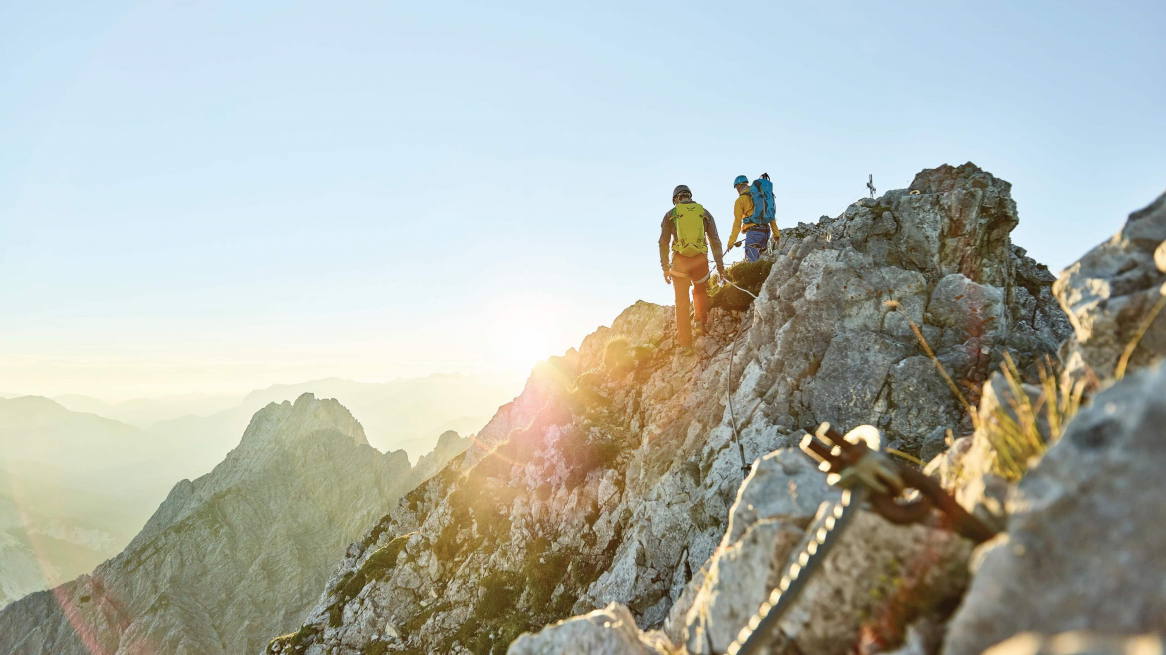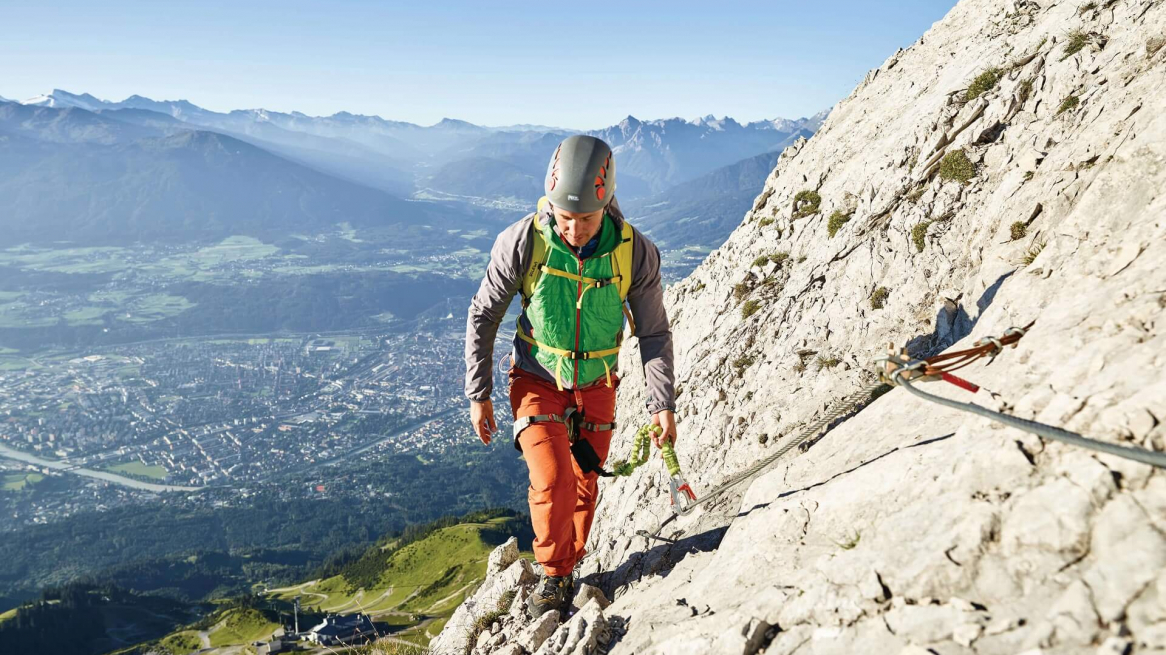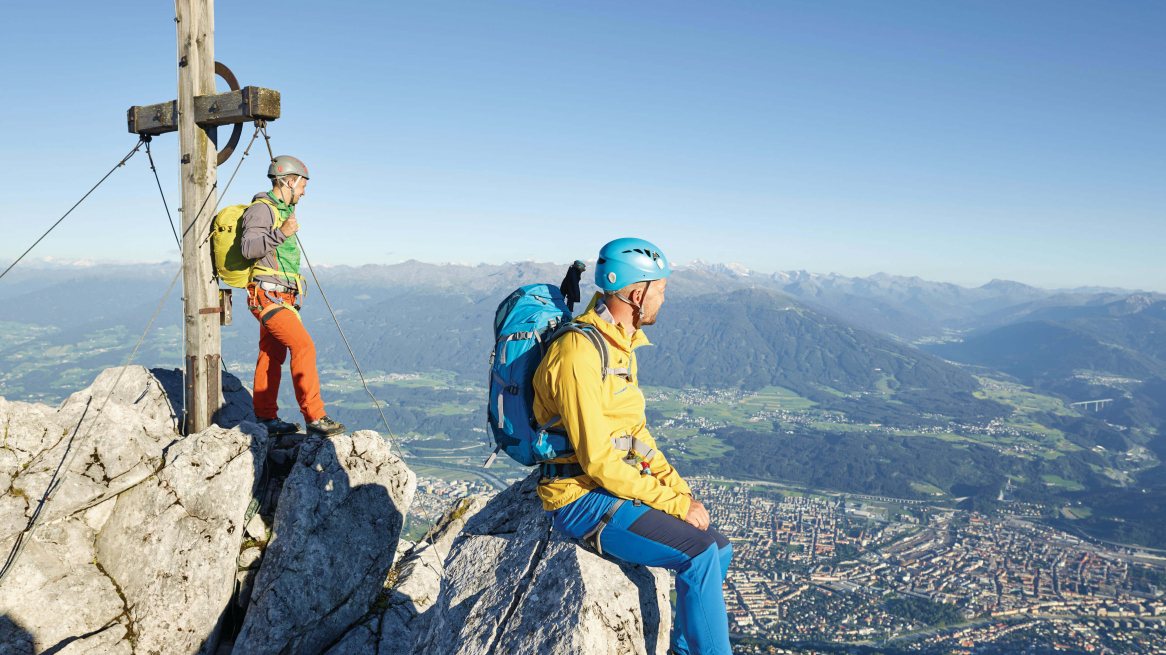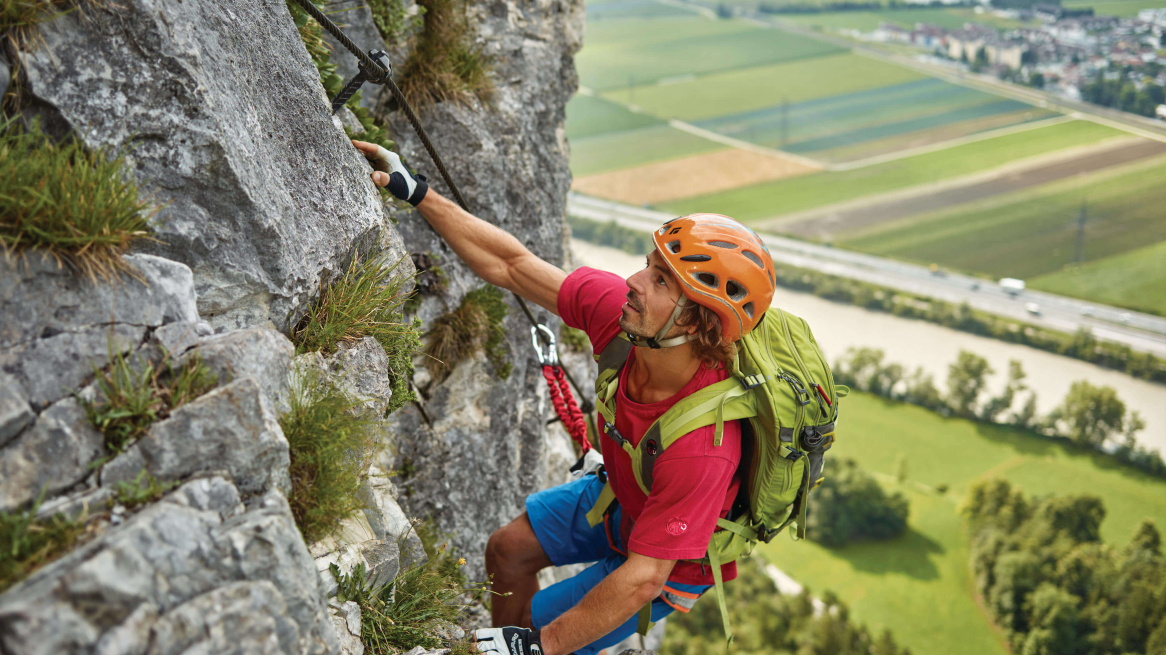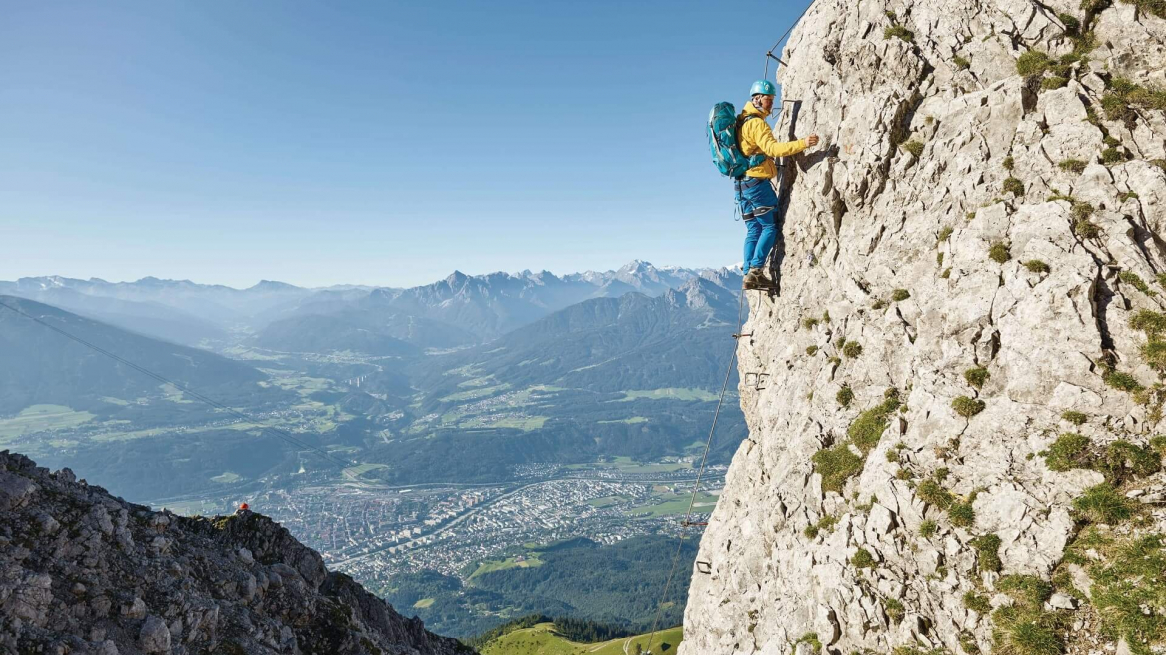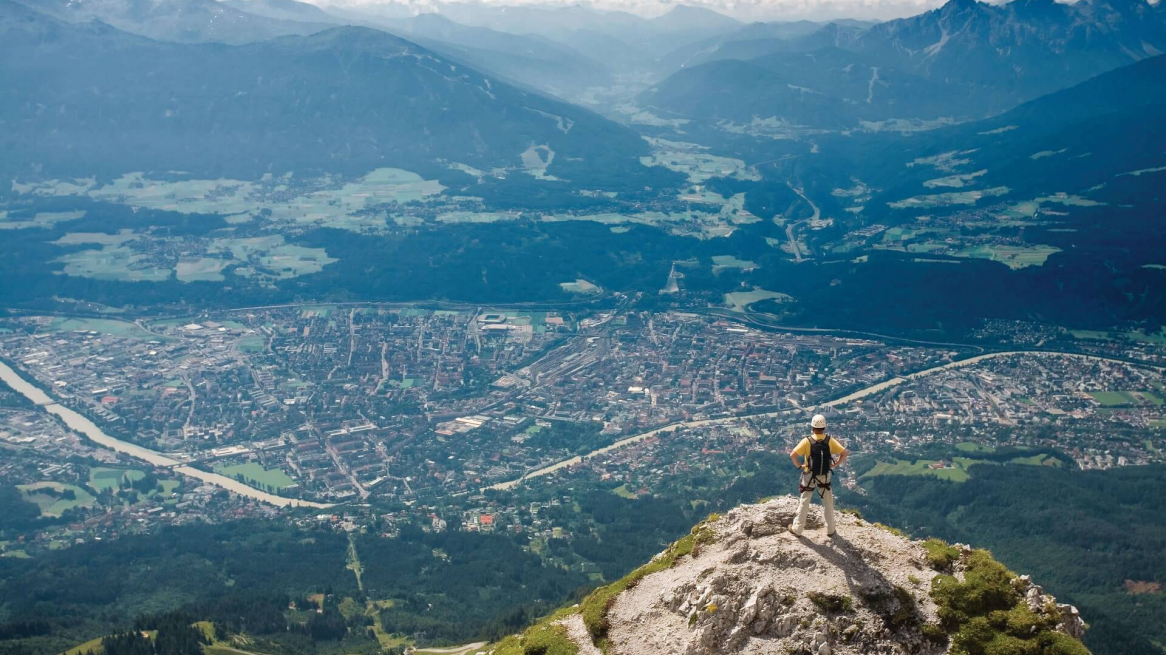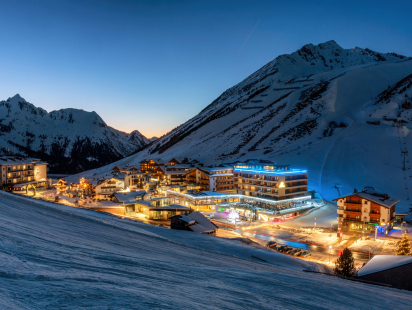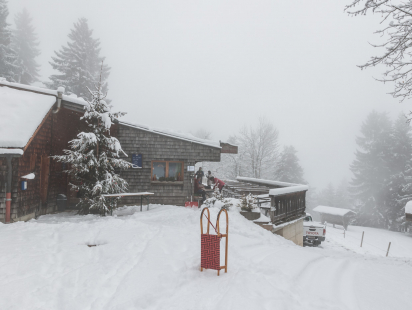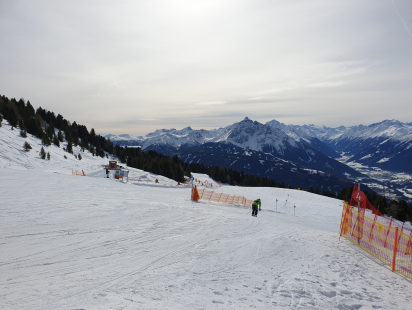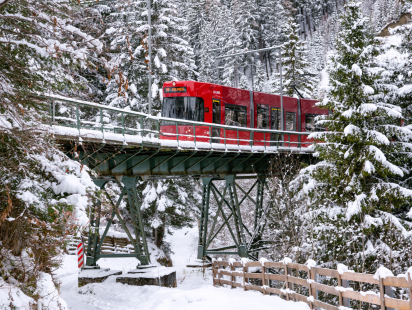What do you get if you combine climbing, hiking and a little bit of scrambling? Via ferrata, of course! Via ferrata is a type of climbing that is popular throughout the Alps and beyond. Why is it so popular? Because—within reason—anyone can do it. You don’t need any specialist knowledge; you simply need the right equipment, a good level of fitness and a head for heights.
Want to give via ferrata a try? The Innsbruck region is home to some great via ferrata routes that are perfect for beginners. If you’re new to the sport and want to know more, here is our beginner’s guide to via ferrata in Innsbruck.
WHAT IS VIA FERRATA?
As we said in the intro, via ferrata (or “Klettersteig” in German) is a type of climbing. But unlike regular sport climbing, you don’t need any rope. Instead, there is a strong metal cable permanently attached to the rock face, as well as other features such as metal steps to stand on, ladders or even rope bridges.
You hook onto the cable using a climbing harness and a “via ferrata set” (which we’ll come to in a minute). Then you climb and scramble your way to the top in whichever way you feel most comfortable! Thanks to the via ferrata set, you are always secured to the rock. If the worst happens and you fall, the rope will catch you and stop you from having a serious accident.
WHAT DO I NEED FOR VIA FERRATA?
The most important things you’ll need for via ferrata are a climbing harness (the same one you would use for sport climbing) and a via ferrata set. This consists of two very strong lengths of elastic rope, each with a carabiner on the end, and a shock absorber in the middle. You attach the via ferrata set to the central loop of your climbing harness using a slip knot. The two carabiners will then be hooked onto the metal cable on the via ferrata route.
In addition, you’ll need the following:
- Comfortable sports or hiking clothes
- Hiking or approach shoes (trainers also work but have less grip)
- Gloves, to protect your hands on the cable
- A helmet, in case of rockfalls
- Sun cream, water and a snack for the top
- A hiking backpack to keep everything in
- A good head for heights! Via ferrata is not dangerous, but it can be very scary if you are afraid of heights. If being up high is not your thing, maybe try one of Innsbruck’s other great summer sports.
Innsbruck Klettersteig Testival
Want to try before you buy? On the 4th of September, the Nordkette in Innsbruck is hosting the third “Klettersteig Testival”, where you can try out harnesses, via ferrata sets and much more, all for free! For more details, check out their website or Facebook page (in German).
Even better, Innsbruck Tourism are running a competition to WIN a fantastic weekend trip to Innsbruck during the testival, including event tickets, a stay for two people in a 4* hotel, 2 Innsbruck Card Lights, and 2 x €100 gift vouchers to spend on kit. Enter the giveaway here >> www.innsbruck.info/en/competition-via-ferrata-testival.html
HOW DO YOU DO VIA FERRATA?
Got your harness and via ferrata set? Then you’re ready to go. Head to the bottom of your chosen route and find the start of the cable. Clip both your carabiners onto the cable. Then slowly start climbing up the rock face, sliding your carabiners along the cable as you go. You can touch any part of the rock you like, including any metal steps or pegs that have been added along the route. As a basic rule, you should have three of your limbs (either two hands and one foot, or two feet and one hand) on the rock at all times—this helps you keep your balance and stay secure.
After a few metres of climbing, you will come to a bolt. This is the metal loop that attaches the cable to the rock. You cannot slide your carabiners past a bolt, so you unclip one and reattach it to the cable on the other side of the bolt, before unclipping and reattaching the other one. Make sure the first carabiner is properly attached to the cable before you unclip the second one, otherwise you will not be attached to the cable!
BEGINNER VIA FERRATA ROUTES IN INNSBRUCK
Via ferrata routes are graded A-E, with A being the easiest and E the most difficult. On the “topo”, or plan, of the route, you can see the different grades included in the route. If you’re a beginner, you should look for a via ferrata route that only has A and B parts.
Doing via ferrata in Innsbruck for the first time? Here are some routes to try.
The Geierwally
This is by far and away the best place to start your via ferrata career. The Geierwally is a short practice via ferrata at the top of Innsbruck’s Nordkette cable car that is ideal for beginners. There are two routes, either an easy A-B route or a slightly harder route with some C sections. It’s great for both beginner adults and children and also offers some of the most amazing views in Innsbruck. What more could you want!
The Silzer Klettersteig
The Silzer Klettersteig (or “Crazy Eddy” as it’s sometimes known) is actually one of the Region Innsbruck’s harder via ferrata routes—mainly due to the massive spider’s web of chains you have to traverse. But what most people don’t know is that there is a short route at the bottom which is ideal for beginners. As an A-B route with one steep C section, you can safely practice your via ferrata skills while still feeling smug about climbing on the famous Crazy Eddy.
The Wankspitze
Yes, the name might be funny to an English speaker but if you’re looking to do your first real via ferrata, then the Wankspitze is a great choice. A 2.5hr hike followed by 1hr via ferrata, this is definitely a route you need stamina for. But if you’re up to the challenge, you will be rewarded with spectacular views of the beautiful Mieminger plateau and the surrounding mountains. A quick top tip: the steepest part of the route is the very beginning. If you can manage that, you will love the rest.
BASIC SAFETY RULES
Like all mountain sports, via ferrata can be dangerous if not done properly. Here are some basic safety rules, for safe climbing fun in the mountains.
- Always wear a helmet: you never know when rocks will fall from above.
- Leave enough space: if you slip, make sure you don’t take out the person below you.
- Overtake in a way that makes everyone feel safe: that’s just common courtesy.
- Choose the right route: choose a route that is appropriate to your level. With via ferrata, there’s no going back down until you’ve reached the top.
- Check your partner’s set: before you start, check your partner has attached their via ferrata set correctly, and get them to check yours.
- Check the weather: via ferrata routes get very slippery when wet and it is not recommended to do via ferrata in the rain. And if a storm is forecast, definitely stay at home! All that metal on top of the mountain is very prone to lightning strikes.
LIKE VIA FERRATA BUT WANT TO TRY “REAL” CLIMBING?
For some people, via ferrata is a good introduction to “real” or sport climbing. Check out this video to find out more about the diverse climbing scene in Innsbruck.
Rate this article
Show me the location on the map
English copywriter and translator based in beautiful Innsbruck. Born in the UK, now living the simple life in the mountains.
Similar articles
Who has experienced them, these clear, cold winter nights in the high mountains? Maybe even under a…
The toboggan run from the Rumer Alm is one of my absolute favorite toboggan runs. At just…
When I came to Austria at the age of 16, winter sports were still pretty exotic for…
Snow-covered forests, exercise in the fresh air, enjoying the winter... I am regularly drawn to go outside,…

